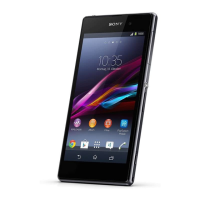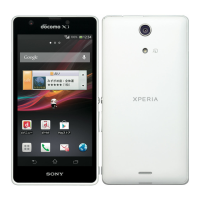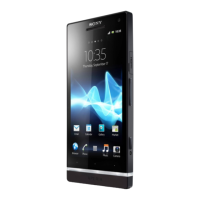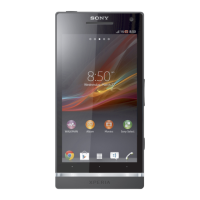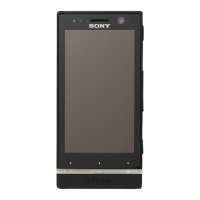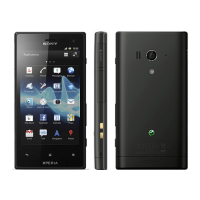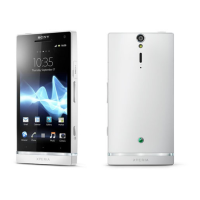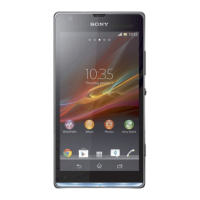Do you have a question about the Sony XPERIA sola and is the answer not in the manual?
Instructions on how to remove and attach the back cover of the phone.
Steps to power the phone on and off, including SIM card PIN entry.
Guide for initial phone setup and basic functions.
How to open and launch applications from Home or Application screens.
Configuring settings for Internet access and sending messages.
How to make emergency calls using international numbers.
Answering, ending, and managing calls, including speakerphone.
Methods for transferring contacts from an old phone to the new one.
Creating, editing, and synchronizing contacts in the phone.
Exporting contacts to memory card or SIM card.
Creating, sending, reading, replying, and forwarding messages.
Steps to add and configure email accounts on the phone.
Composing, sending, receiving, and managing email messages.
Downloading free and paid applications from Android Market™.
Managing your time schedule and synchronizing with web calendars.
Setting, editing, and managing alarms on the phone.
Setting up and manually syncing with Google™ services.
Accessing and syncing corporate email, calendar, and contacts.
Accessing the Internet wirelessly via Wi-Fi® networks.
Selecting links, zooming, reloading pages, and adding shortcuts.
Playing audio content, browsing libraries, and using player controls.
Taking photos using the camera key, touch screen, or on-screen button.
Connecting your phone to other Bluetooth™ devices like headsets or car kits.
Transferring files between phone and computer using a USB cable.
Tracking location, viewing traffic, and getting directions with Google Maps™.
Enabling SIM card lock, changing PIN, and unlocking with PUK.
Setting up a screen unlock pattern, PIN, or password for phone security.
Downloading and installing software updates wirelessly via Update Center.
Updating the phone using PC Companion via a USB cable connection.
Basic troubleshooting steps for phone malfunctions.
Restoring the phone to original settings, with or without deleting data.
Instructions on how to remove and attach the back cover of the phone.
Steps to power the phone on and off, including SIM card PIN entry.
Guide for initial phone setup and basic functions.
How to open and launch applications from Home or Application screens.
Configuring settings for Internet access and sending messages.
How to make emergency calls using international numbers.
Answering, ending, and managing calls, including speakerphone.
Methods for transferring contacts from an old phone to the new one.
Creating, editing, and synchronizing contacts in the phone.
Exporting contacts to memory card or SIM card.
Creating, sending, reading, replying, and forwarding messages.
Steps to add and configure email accounts on the phone.
Composing, sending, receiving, and managing email messages.
Downloading free and paid applications from Android Market™.
Managing your time schedule and synchronizing with web calendars.
Setting, editing, and managing alarms on the phone.
Setting up and manually syncing with Google™ services.
Accessing and syncing corporate email, calendar, and contacts.
Accessing the Internet wirelessly via Wi-Fi® networks.
Selecting links, zooming, reloading pages, and adding shortcuts.
Playing audio content, browsing libraries, and using player controls.
Taking photos using the camera key, touch screen, or on-screen button.
Connecting your phone to other Bluetooth™ devices like headsets or car kits.
Transferring files between phone and computer using a USB cable.
Tracking location, viewing traffic, and getting directions with Google Maps™.
Enabling SIM card lock, changing PIN, and unlocking with PUK.
Setting up a screen unlock pattern, PIN, or password for phone security.
Downloading and installing software updates wirelessly via Update Center.
Updating the phone using PC Companion via a USB cable connection.
Basic troubleshooting steps for phone malfunctions.
Restoring the phone to original settings, with or without deleting data.
| Announced | 2012, March |
|---|---|
| Weight | 107 g (3.77 oz) |
| SIM | Mini-SIM |
| Resolution | 480 x 854 pixels, 16:9 ratio (~265 ppi density) |
| Protection | Scratch-resistant glass |
| OS | Android 2.3 (Gingerbread), upgradable to 4.0 (Ice Cream Sandwich) |
| Chipset | NovaThor U8500 |
| CPU | Dual-core 1.0 GHz Cortex-A9 |
| GPU | Mali-400 |
| Internal Storage | 8GB (5GB user available) |
| RAM | 512MB |
| Main Camera | 5 MP, AF |
| Video | 720p@30fps |
| Loudspeaker | Yes |
| 3.5mm jack | Yes |
| GPS | Yes, with A-GPS |
| NFC | Yes |
| USB | microUSB 2.0 |
| Sensors | Accelerometer, proximity, compass |
| Battery Type | Li-Ion 1320 mAh, removable |
| Talk time | Up to 6 h (2G) / Up to 5 h (3G) |
| Dimensions | 116 x 59 x 9.9 mm (4.57 x 2.32 x 0.39 in) |
| Display Size | 3.7 inches |
| Card slot | microSDHC |
| Features | LED flash |
| WLAN | Wi-Fi 802.11 b/g/n, DLNA, hotspot |
| Radio | Stereo FM radio, RDS |
| Colors | Black, White, Red |
| Display Type | LED-backlit LCD, capacitive touchscreen |
| Bluetooth | 2.1, A2DP, EDR |
| Stand-by | Up to 470 h (2G) / Up to 460 h (3G) |


